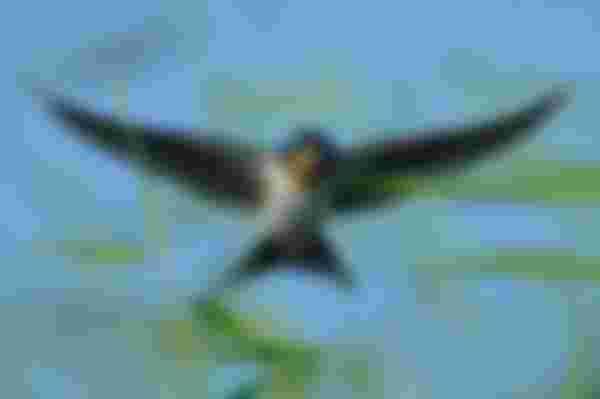Today I will share with you everything about swallows, general information, the problems they cause and how to protect yourself.
Swallows are small, very hardy birds of the genus Singer. They are considered to originate from Africa, where the largest number of species of the known 143 varieties live.
In the domestic climate, there are five species of swallows (rural, urban, mountain, Daurian and bregunica), of which we most often see rural and urban. They differ in appearance, to some extent in behavior, which has always been amazing for a person.
Village swallows have stretched out,
muscular body, short neck, flat head with wide
beak, long legs with separated toes. The upper part of the body and neck are bluish-black with a metallic sheen, the forehead and throat are auburn, and the other lower parts of the body are yellow. In females, all colors are paler than in males.
The deeply split tail enables rural swallows to manipulate the air extraordinarily and hover, flutter, swim in the air, change direction abruptly, turn on their backs, sink quickly, but return to height even faster, which makes them the most agile of all domestic swallows.
City swallows are more numerous than rural and smaller ones, they are only 14 cm long. They are characterized by a shorter and less split tail, as well as white feathers on the lower side of the body. They do not fly as fast as village swallows, their turns are not very fast, although the flight is characterized by a change in altitude, they fly low and high alternately. Urban swallows are more durable in the air and fly at higher altitudes than rural swallows. Due to the structure of their legs, swallows cannot sit or walk.
Prevalence:
Where do swallows live?
Swallows inhabit all continents except Antarctica. They are adapted to living with people and form rocks only in areas where there are no human settlements. They are the most famous migratory birds that leave the cold in the fall and go to the warm, southern parts of the earth's hemisphere.
Swallows hunt for food in the air during the summer, including insects, mostly biplanes, membranes, butterflies and beetles, while bees and wasps do not catch them. When it rains, they fly at high altitudes where they find food. If the rainy weather lasts, the swallow, which otherwise needs a lot of food, flies over the shelter of insects in order to make them fly and thus get a meal.
Seobe lasta
In late September and early October, swallows gather in large flocks and move to warmer regions. City swallows move somewhat later in the fall, and typically take off immediately after sunset.
Swallows are incredibly hardy birds that can fly 8000 kilometers continuously! During migrations, these birds are widespread in Africa, in the lowlands of India, in Ceylon and even reach Indonesia. Any migration of swallows poses a great danger and many die of starvation, exhaustion or storms over a long journey. During the migration, they occasionally rest in the woods or land on boats, which is why they represent the hope for sailors to move in the right direction.
In the spring, they return to their homeland individually, and unmistakably to their old nests.
Specifics:
Small hosts - nests
For their homes, these birds choose parts of buildings, houses or stables that are protected from above by a ceiling, roof, canopy to protect themselves from rain, drafts and storms. It is rare to see a single swallow's nest, usually entire settlements.
They make their nests from muddy, greasy earth, which they collect in crumbs, and then one by one they cover it with sludge, after which they carefully stick it to the wall. They also use fine pieces of grass and hair in the construction, and the basic binding material that gives strength to the nests is saliva. They cover the inside of the nest with feathers, soft grass, hair and other soft materials.
A pair of swallows together build a nest that resembles a hemisphere in shape in a period of one to two weeks. If they are preserved, the nest is used by parents or generations for several years, and before each laying of eggs, they thoroughly clean the inside and bring in new, soft coating materials. External damage is very cleverly repaired, they can even patch holes in the walls!
During spring and summer, swallows nest twice. In May, the female lays four to six white eggs with ashy gray and reddish brown spots. If the weather is favorable, it lies on them for 12 days, and if it is rainy, it is forced to come out of the nest and hunt for food, so the young hatch even after 17 days.
Both males and females feed the young, which grow quickly and can take off in the third week of life. The parents take care of them for some time, feed them and take them back to the nest every night, and when they are sufficiently trained, they sleep outside the nest and live independently. In early August, swallows have another litter. Sometimes the second litter can be late, so both old and young birds are endangered, and if everything is in order, the young birds are already trained to fly, so they gather with the older ones in flocks and set off.
Interesting facts:
Swallows announce rain
According to the movement of the swallow or. according to whether it flies in the higher or lower layers of the air, people estimate what the weather will be like. The weather will be nice when the swallows fly high, bad when they fly low. The explanation is simple, during rainy weather, insects stay closer to the ground, and therefore swallows fly low.
With the goddess constantly moving, the swallow needs a disproportionate amount of food and eats as long as it flies.
The most developed of the senses is sight. He can see a small insect in flight from a great distance. As skilled builders, they repair nests, but also holes in the walls. The swallow is a symbol of spring and is given many meanings in folk beliefs.

life and problems with swallows:
Damage caused by swallows
swallow-feed-young The biggest problem that swallows create in urban and rural areas are nests that are made of mud, and which damage and soil the facades of buildings. Apart from the fact that mud leaves ugly stains as a building material, the feces of these birds are also a big problem.
Swallow droppings are collected and piled up around the nest. Bacteria, fungi and parasites found in feces and nests can be the cause of serious diseases such as: histoplasmosis, encephalitis, salmonella, meningitis, toxoplasmosis.
In addition, beetle nests are collected along with swallow nests, which is an additional problem.
Ecological protection against swallows
These small and tender birds are protected by law and therefore only ecological means are used to defend against these birds.

First of all, it is necessary to thoroughly clean and disinfect the places where swallows made their nests.
networkNetwork for birds is always a good choice to prevent access to all objects where this bird makes a nest,
If possible, make or purchase moldings that reduce the angle between the walls by 90 degrees.
Ultrasonic bird protection devices are extremely effective in protecting against swallows.
I hope you learned a little more about swallows.

